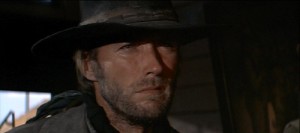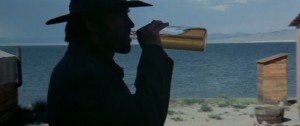Warner (Malpaso Production)
 Clint Eastwood made a strong impression with his third directorial assignment, the Western High Plains Drifter, in which he showed a self-assured style, influenced by two of his mentors and frequent directors, Sergio Leone (the Spaghetti Westerns) and Don Siegel (“Dirty Harry” and others).
Clint Eastwood made a strong impression with his third directorial assignment, the Western High Plains Drifter, in which he showed a self-assured style, influenced by two of his mentors and frequent directors, Sergio Leone (the Spaghetti Westerns) and Don Siegel (“Dirty Harry” and others).
Yet Eastwood’s approach is all his own, combining the direct and efficient strategy of Siegel while refraining from the operatic excess of Leone.
End result is one of the best Westerns of the 1970s, a decade in which John Wayne, the main proponent of the genre, made only few good pictures. The only other filmmaker to leave his mark on the genre was Sam Peckinpah.
A morality tale set in the harsh Western desert, the saga begins when a mysterious stranger (the character’s mythic name is “The Stranger”) appears out of nowhere. He rides into the small town of Lagos, where his presence threatens the largely mean and cowardly populace. Before too long, hes attacked by three gunmen, and kills them all coolly. The Stranger than rents a hotel room, and the town dwarf, Billy Curtis (Mordecai), whos also disenfranchised in town due to his stigma, attend to his needs.
 At night, the Stranger’s dreams are plagued by a recurring nightmare of a helpless man being whipped to death in the street by some sadistic criminals, while the townsfolk stand by and do nothing to stop him.
At night, the Stranger’s dreams are plagued by a recurring nightmare of a helpless man being whipped to death in the street by some sadistic criminals, while the townsfolk stand by and do nothing to stop him.
This film offers yet another critical commentary on Zinnemann’s “High Noon.” Like that 1952 Western, in this one, the town council debates how to handle the impending threat created by a wild bunch of escaped convicts, who are about to return to Lagos (where they committed their crimes) and destroy it. Desperate, the towns leaders cautiously ask the Stranger save their town from the criminals. He agrees to help them, but then proceeds to turn the town on its head by teaching self-defense and requesting all sorts of strange things from the townsfolk, including having the town repainted in red and renaming it Hell.
 Most critics saw “High Plains Drifter” as a supernatural Western that takes the avenging man-with-no-name character, created by Eastwood and Leone, to its most logical extreme. Eastwood would later bury the character completely in his own film, “The Outlaw Josey Wales,” only to have him redefined as a much more human, compassionate and caring hero.
Most critics saw “High Plains Drifter” as a supernatural Western that takes the avenging man-with-no-name character, created by Eastwood and Leone, to its most logical extreme. Eastwood would later bury the character completely in his own film, “The Outlaw Josey Wales,” only to have him redefined as a much more human, compassionate and caring hero.
Eastwood liked the story’s strange, offbeat quality, and approached Universal with the idea of directing it. The screenplay was written by Ernest Tidyman, an Oscar winner for The French Connection. Tidyman’s screenplay was inspired by the real-life murder of Kitty Genovese, in Queens in 1964. The text, which contains black humor, was retouched by Dean Riesner, one of Eastwood’s associates.
Eastwood insisted on shooting the film on location, scouting sites in Oregon and Nevada, before having the entire town of Lago built on the shores of Mono Lake. Additional scenes were shot at Reno, Nevada’s Winnemucca Lake and California’s Inyo National Forest. The film is beautifully shot by ace lenser Bruce Surtees, who finds the right imagery to illustrate the often surreal and ghostly narrative.
Rather unusually, Eastwood shot High Plains Drifter in sequence, and reliably completed the shoot in six weeks, two days ahead of schedule, and under budget.
Tributes
The graveyard set the film’s finale had tombstones reading “Sergio Leone” and “Don Siegel,” intended as tribute to the two most influential directors on his career. Marshal Duncan was played by the stuntman Buddy Van Horn, Eastwood’s long-time stunt coordinator, in order to increase ambiguity as to whether he and the Stranger are the same person. In earlier versions of the script, the Stranger was the dead marshal’s brother, but Eastwood deleted the reference.
Cast
Clint Eastwood as The Stranger
Verna Bloom as Sarah Belding
Mariana Hill as Callie Travers
Billy Curtis as Mordecai
Mitchell Ryan as Dave Drake
Jack Ging as Morgan Allen
Stefan Gierasch as Mayor Jason Hobart
Ted Hartley as Lewis Belding
Geoffrey Lewis as Stacey Bridges, outlaw
Dan Vadis as Dan Carlin, outlaw
Anthony Jamse as Cole Carlin, outlaw
Walter Barnes as Sheriff Sam Shaw
Paul Brinegar as Lutie Naylor
Richard Bull as Asa Goodwin
Robert Donner as Preacher
John Hillerman as Bootmaker
John Quade as Freight Wagon Operator
Buddy Van Horn as Marshal Jim Duncan
William O’Connell as the Barber
Scott Walker as Bill Borders
Credits
Running time: 105 minutes
Produced by Robert Daley
Directed by Clint Eastwood
Screenplay: Ernest Tidyman
Camera: Bruce Surtees
Editor: Ferris Webster
Music: Dee Barton
Art Direction: Henry Bumstead



